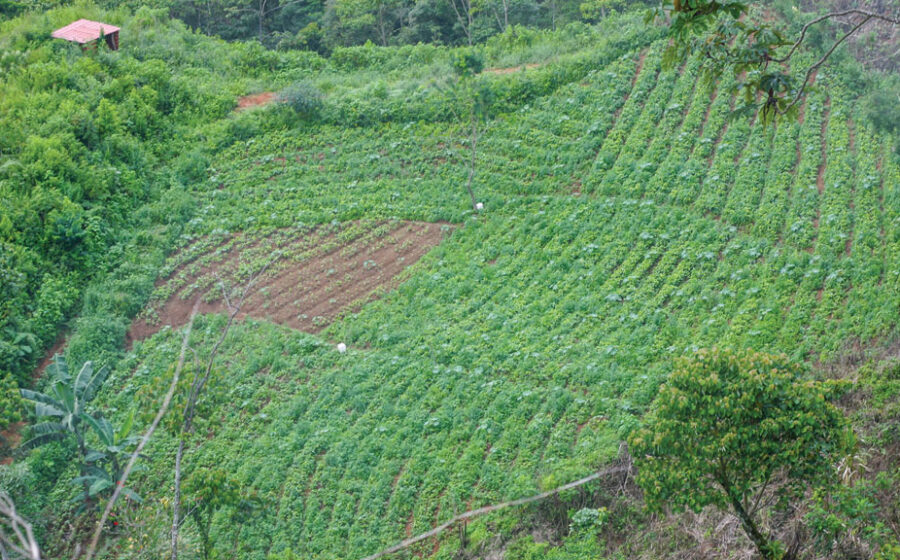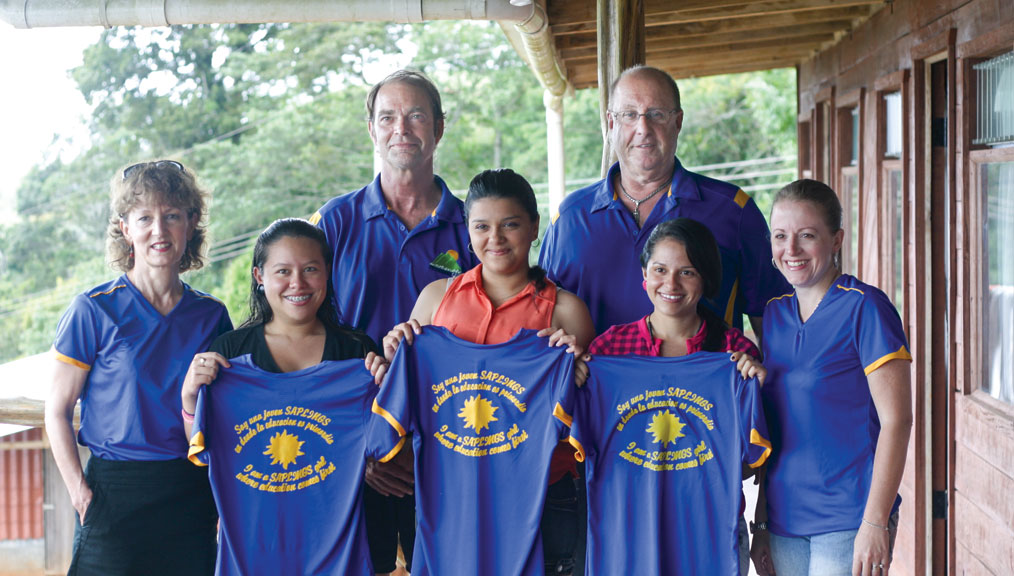[T]en years ago, lifelong friends Bill Bayer and Mike Pannell thought they had a brilliant plan for retirement. “We figured we would buy a beautiful piece of property in Costa Rica, grow some coffee on it, and make a bunch of money. How hard can it be?” Pannell says. “If only we had known how wrong we were.”
The dos locos gringos, as they are affectionately known to friends and family both stateside and in Costa Rica, started their coffee-growing endeavor with big aspirations and little clue about what they were undertaking. They selected an absolutely stunning piece of property in the Cerro Turrubares mountains, overlooking the Pacific Ocean on Costa Rica’s west coast. The fifty-one hectares of land had formerly been cow pasture and was essentially abandoned, but lay in the heart of a tiny mountaintop community called la Potenciana. “We immediately fell in love with the location when we saw how breathtaking it was,” Bayer says, “but we stayed in love with it because of the people who call Potenciana home.” It was the people and spirit of this remote community that inspired Bayer and Pannell to pursue and then adapt and ultimately transform their coffee-growing dreams from illusions of easy income into achievable goals of rural revitalization.
Costa Rica has earned a reputation for showcase coffee from glamorous micro-mills, or of being a tourist country with acceptable infrastructure. Neither of these preconceptions hold true for Potenciana. The community of several families and less than fifty people sits on the crown of a mountain and is undeniably remote. Electricity only arrived within the last ten years, and as recently as twelve years ago there were no real roads, and therefore no one owned a vehicle. People still relied on horses to ride up from and down to the nearest bus stop several miles away.
Luis Angel Venegas, a protagonist in the story of la Potenciana, describes the almost mythic origins of how the community began. “Fifty years ago, which is how old I am, when my dad came, it was just mountain. There was barely any cleared area for houses and the ranchos for animals. These all used to be ox paths, back when everyone had oxen. And the rest was mountain on all sides. The story of Potenciana, supposedly, is that a couple of newlyweds were on their way up to what is now Potenciana. The bride was named Ana. As they were climbing, it was so steep she didn’t think she would make it. So her new husband kept telling her, ‘potencia, Ana,’”—strength, Ana—“so that’s where the name comes from. Potenciana.”
Prior to the arrival of Bayer and Pannell and their coffee enterprise, called Potenciana Café, there were no paying jobs in the tiny community and this lack of stable income meant that more and more of the few families in Potenciana were losing members to bigger towns and cities as they sought work. The residents with the fewest options were the young women. After completing sixth grade at the local primary school (whose string of teachers from other towns was far from reliable), few families could afford to send their daughters to the nearest high school two hours away and pay the costs of uniforms, books, and meals. Young men in the community were slightly more likely to continue on to high school because it was more feasible for them to find occasional work as laborers while studying.
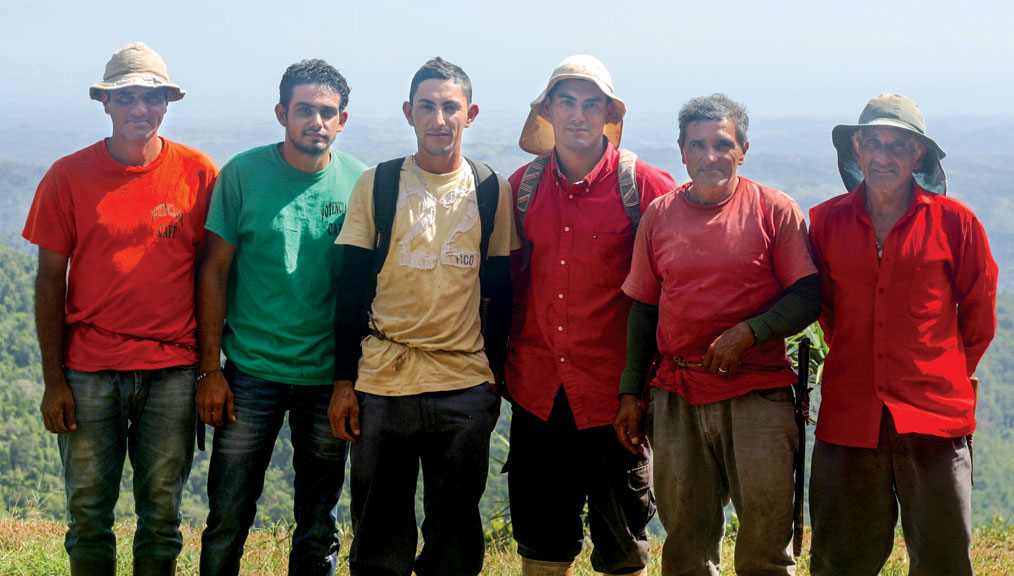
Local education was not at the top of the list of challenges Bayer and Pannell planned to tackle. When they acquired their mountain farmland they were faced with problems of extreme erosion due to degraded soil after decades of poorly managed cattle farming, roads that were nearly impassible during the rainy season, electricity that regularly shorted, and they had no idea who to trust for reliable coffee seed stock. Other landowners on different sides of the mountain were growing coffee, but with different degrees of success and at varying levels of quality.
Any of the complex natural, bureaucratic, or financial strains that accompany agriculture could have been reason to abandon the project. For expats as much as for nationals, discouragement and frustration with the uncontrollable can be the biggest obstacle to launching an agricultural enterprise. Compounding these difficulties, Bayer and Pannell still worked full time in the United States. (Bayer retired from the Air Force and works for a defense contractor in Florida. Pannell is an industrial hygienist currently working at NASA.)
Soon, though, Bayer and Pannell were infused with the same spirit of determined strength that gives the community its identity. They were not deterred by the low prices offered by the only buyer in the area; they lobbied for over a year to convince a cooperative, Coopeatenas, to build a receiving point to buy coffee from the Turrubarres region. When their vehicles were stuck in several feet of mud, the locals demonstrated the towing strategies they have developed to survive the rainy winters. The gringos used local building strategies to keep zinc roofs attached in extreme winds, and they learned the ways to effectively car pool and communicate in order to make every trip up and down the mountain count, always remembering to keep an extra couple gallons of gasoline on hand and to choose wisely the vehicles in which to make the assent in the first place. They adopted the kind of creative problem solving that Potenciana residents have employed from the beginning to adapt to life on the steepest, farthest peak of the mountain.


One year at a time, Bayer and Pannell turned challenges into successes. At the recommendation of neighboring farms, they purchased quality nursery plants, then germinated their own the next several years. To prevent further erosion, they reforested particularly vulnerable tracts with native trees and constructed barriers. As coffee producers, they were entitled to agronomy services from the national Institute of Coffee, ICAFE, and they took advantage of its knowledge. They used their own elbow grease to reinforce utility infrastructure.
They relied heavily on local labor at every stage, but they also did something crucial that so many foreign entities fail to do when they try to make changes in another country: they secured their own oxygen mask before securing those of others; they made sure their own business was operable before trying to make any sort of social change.
Potenciana Café’s successes in philanthropy and goodwill started from a desire not to save the world or to give something away but quite the opposite. They worked to build a business that would generate reliable revenue for its owners. There are countless instances of aid to the coffee lands, be it donations to support food stability or healthcare and medical screenings or computers or construction of schools and community buildings. Unfortunately, one characteristic shared by so many of these well-intended projects and initiatives is that they show up suddenly, and disappear quickly.
Aid projects are often established with two- to five-year timelines for pilot phases, which then never make it past reevaluation. Because Potenciana Café arrived as a business, it began with the long-term in mind. Growing coffee is slow, but Bayer and Pannell were in no particular rush because they were building something they intended to enjoy for the rest of their retirement. Aid often has to answer to multiple donors or funders, and quickly. The Dos Locos Gringos had the luxury of time.
Even with that luxury, they very quickly saw that investments in reforestation and quality seed stock were far from enough; for their business to thrive they had to invest in the people who would make their business function. It would be years before either Bayer or Pannell could end their careers and live full time at the farm. In the meantime, they needed to hire people they could trust.
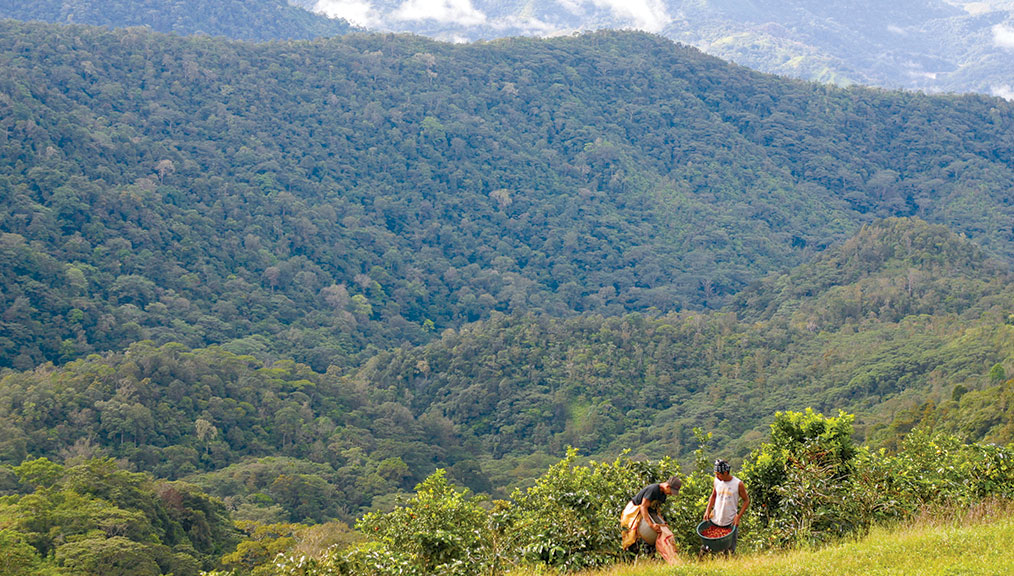
[I]t is a much repeated fact that coffee often sells for prices well below the cost of production. Farm owners who are from developed countries, and who are not reliant on coffee production for survival have access to the financial tools that, luckily, allow them to manage that kind of risk. Local growers rarely have access even to credit, never mind more sophisticated hedging tools, and a bad harvest can mean watching their families go hungry. Being a coffee producer is rarely a stable position, but being a full-time farm employee is.
Luis Angel Venegas, who told the story of Potenciana, has been the company’s most reliable presence. He started as a worker, rose to assistant manager, and is now the farm’s mandador, the foreman, the one who makes the decisions about what to do and when. After the harvest cycle finished this season, he set workers to trimming branches to prevent plagues and rotting caused by excess humidity among the bases of leafy coffee trees.
He has the quiet wisdom of someone who has spent the majority of his life immersed in the mountain calm. His deeply tanned and lined face breaks into a grin whenever he tells a story of the antics of his bosses, and he rattles dates and numbers into the wind as I scramble to keep up behind him as he takes me between lots to showcase his favorite corners of the property. His expertise is in coffee, but he has slowly grown into his role as manager. When I arrived this February, it was the end of the work day and he was diligently recording the employee’s hours into a log book and making a list of their shoe sizes to order new black rubber work boots. He is the sole driver of the four wheeler, dubbed “Malacrianza” after the famed bull, used to haul people and products around the farm.
Along with Venegas, there are seven core employees, including Jefry Lopez, who’s twenty-five, and has worked for the past year as a farmhand and driver for Potenciana Café. He recently invested in a motorcycle to make the daily twenty-five-minute drive up to the farm. There’s also Jeudy Trejos, twenty-eight, who travels up the mountain from his home in another small rural community. Along with them, there are more than twenty seasonal employees, all of whom earn the benefit of Costa Rican social security because of the work.

Just as important as creating a retirement nest egg for themselves, one that would also produce jobs for their neighbors, there’s something now maybe even more important to Bayer and Pannell; they wanted to create the kind of community where they would want to live. “I saw the young women here having babies of their own in their teens, without ever having a chance to experience education or even explore what they might want to do in life,” says Bayer. “Mike and I each have sons and grandchildren, and we kept thinking about what their lives would be like if our families never had the means to educate them beyond sixth grade. We knew we had to do something.”
That something was forming a non-profit called Saplings that provides scholarships for girls in Potenciana to attend high school, support to the local primary school, and support for community infrastructure. Of course Bayer and Pannell as individuals and Potenciana Café as a business were among the most enthusiastic donors, but people from across the United States eagerly supported the mission. Guadalupe Venegas, Luis Angel’s third of four daughters, was among the first four recipients of the scholarship. In December of 2014, she graduated from high school and has taken her first two college courses.
“When they first told us we’d be receiving scholarships, you have no idea how happy we were! I showed that I was passing my classes and graduated in 2014,” says Lupe, as she’s known. “Now I’m studying business administration. I would like to run a business . . . preferably a big one. You can only learn so much from school. I’m ready to work because that’s how you learn how to actually solve problems.” Another scholarship recipient, Alejandra Porras, said the scholarship came at the perfect time. Receiving the scholarship allowed her to finish her studies and prepared her for a job at Banco de Costa Rica as an executive secretary.
Lupe’s first job was picking coffee for Potenciana Café, working among the bushes with her parents during school vacation. Eventually she helped manage accounting during harvest, ensuring the pay of the twenty-plus seasonal pickers, many of whom, she notes, are local women with families who cannot travel far from home and have no other source of income in their home community.
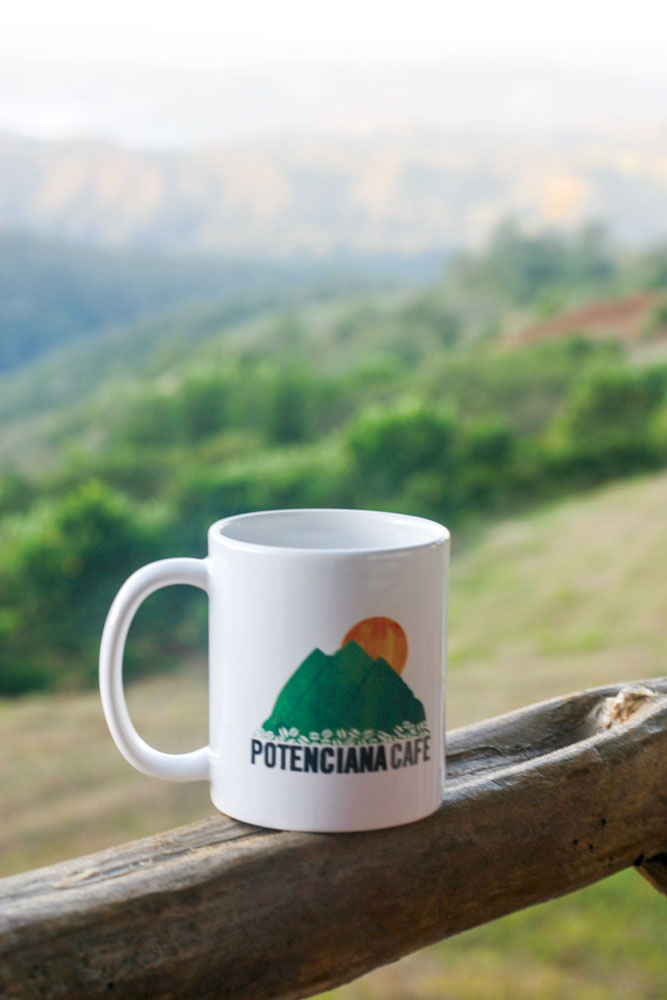
Potenciana Café also creates a phenomenon that is nothing short of miraculous compared to the trend it fights against: a draw back to the mountain instead of a push away from it. Costa Rica, like the rest of Central America, is facing a crisis of urban migration. A lack of rural jobs that offer living wages drives people to flood to cities looking for work. Bayer and Pannell showed up in Costa Rica ready to invest in starting something. They, like other foreign investors, could have chosen to buy a condo in the suburbs or rent office space in a new urban high rise. Coffee offers the spectacular opportunity—in Costa Rica and in every producing country—to invest in the middle of nowhere and draw people back to sustainable rural livelihoods.
It is possible to build reasons for families to remain in rural communities, but it takes patience and a willingness to suffer trials and errors. Bayer and Pannell originally planted their farm with red and yellow catuai and caturra plants; however, in favor of diversification they have also raised over 10,000 geisha plants from seed. Their investment in sustainable practices, consistent care at the microbial level in the soil, and in the people has been wildly productive.
I walk with Luis Angel Venegas as he points to where the thousands of one-year-old geisha plants already stretch up past my waist. “We have about 60,000 coffee trees planted on the property right now. About 4,000 plants per hectare. It’s pretty amazing,” he says. “I was telling my wife the other day, ‘Did you ever think you would see the mountain like this, with clear roads and so many orderly plants of coffee after it was just forgotten cow pasture for so long?’ She could never have imagined it either. But, we keep going from here. The world gives many turns.”
Potenciana Café is growing the farm steadily, with another 20,000 plants growing from seed this year, and will continue to do so until they reach 120,000 plants. This will allow them to ensure 100,000 plants are always in full production.
Bayer and Pannell have plans in the works to build a wet mill and eventually sell their coffee more directly. I ask Lupe, Luis Angel’s daughter, if she would ever want to manage a farm that grows and processes coffee. “Administer a coffee company? A big coffee company?” she pauses, then beams. “Coffee is what I grew up with and what I know; that would be a dream come true!”
—Rachel Northrop is a freelance writer and the author of When Coffee Speaks: Stories from and of Latin American Coffeepeople.

